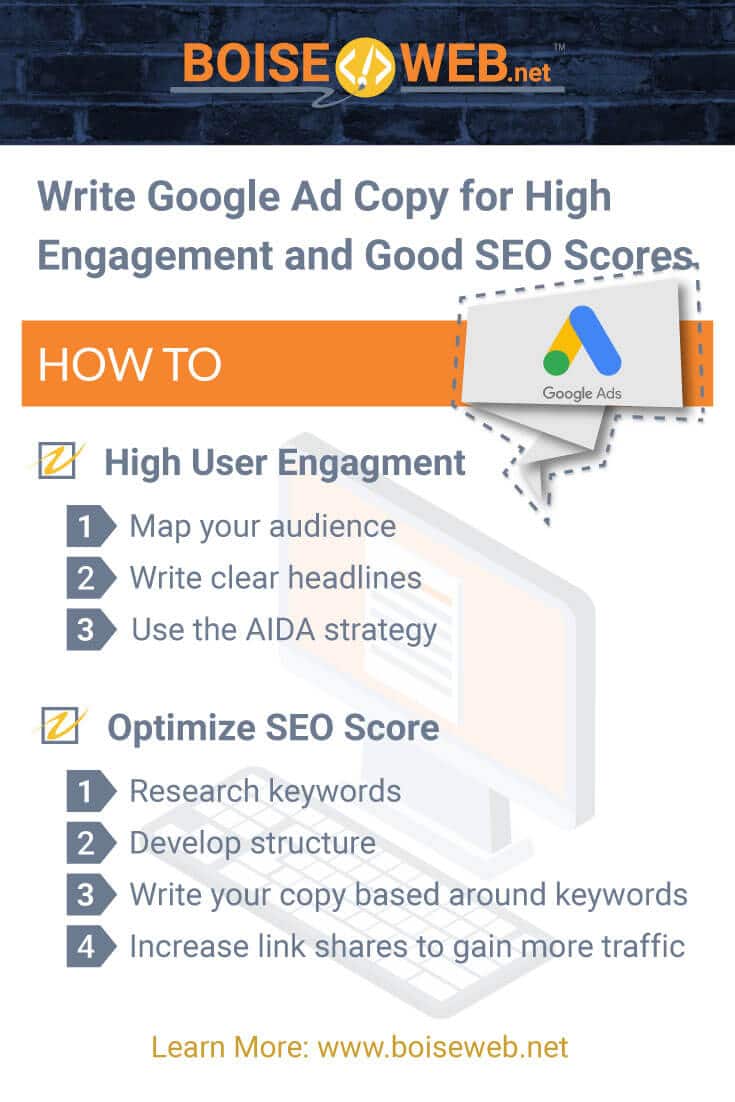SEO can have a huge impact on your business, so understanding how to optimize it is crucial. However, having good SEO scores only does so much, you also need a high user engagement and for people to be interested in what you have to say to be truly successful.
What is SEO?
When you’re searching for something on Google, you’ll get a list of websites that pop up. A few of these will be advertisements, and then there will be the websites that Google naturally generated for your search. These naturally generated websites are the sites that have the highest SEO ratings. SEO stands for search engine optimization, and it is the process of selecting the most relevant and most authoritative of sites for your search. Understanding how SEO works allows you to optimize your content to help boost that SEO rating.
Authority
Google boosts web pages with more authority than others. What does this mean, though? Google doesn’t actually look at your website to determine this. You may be thinking, how is Google going to possibly know if my website has authority if it doesn’t even look at it? Google looks at your website link and sees how many times it has been posted on other websites. In other words, how many other sites have pointed people back to your site. However, Google also looks at how trustworthy these links are. If it looks like the links aren’t trustworthy then regardless of how many there are your SEO won’t get boosted. For your website to have authority you must have other reliable websites link people back to your website. A lot of copy writers will often collaborate, working together to link people to each other’s sites and boost SEO ratings for everyone involved. However, keep in mind that the quality of these links is far more important than the quantity of these links.
Relevance
Relevancy is the part where Google actually takes a look at your site to see the type of content people can expect to find. There are several factors that play in to how relevant your site is, but a big one to keep in mind for copy writing is the usage of certain words. These buzzwords will often be put in your title or in your advertisement and are then repeated throughout the content of your website. This tells Google that when someone searches for that buzzword, your website will actually provide them with the information that they are looking for. Staying on topic throughout your content and understanding how to use buzzwords can boost your SEO score a lot. If you have all these buzzwords in your ads or in your title but then none of them are repeated throughout your content Google will think that the content on your site doesn’t match what you told the reader it would say. It’s also important to keep in mind not to go overboard on these buzzwords, also called keywords. Focus on one or two throughout your copy to get the highest SEO boost.
What is copy?
Copy is just another word for content, or the writing that is on your website. Writing copy can be difficult when you need to focus on keeping your readers happy while also boosting your SEO and writing for search engines. In order to be successful, you have to go beyond just writing content. In addition to the ways that you can optimize your SEO and follow best practices, which we will talk about in a moment, your copy must be able to solve and problem and appeal to end user.
How to write copy for high user engagement
1.Map your audience
The first step in understanding how to attract high user engagement and get your content in front of the people that will be most interested in it is to understand your audience. Who are they? What do they do? Picture the kind of person that would be interested in your content. How old are they? What do they want? What problem do they have that you can solve for them? What is their schedule like? Mapping out the kind of person that will be most interested in your product is what’s going to make you the most successful. Ask yourself these questions and others to give yourself a clear idea of who this person is. From there, you can target your copy to match their goals and needs. Think about what time they would be looking for this information, what kind of role they would play in purchasing things within their household, the main types of media they would consume, etc. All of this information will give you a great insight into your target audience and can give you a lot of direction when it comes to when and where to present your content.
2.Write clear headlines
Statistically, if 80% of the people that see your ad visit your website, only 25% of that 80% will actually stay on your website to read your copy. That’s only 2 out of every 10 reading your copy. One of the ways that you can reduce bounce back is by having clear and concise headlines. It’s been proven that wordy or confusing headlines don’t do well and click-baiting does even worse. You need to tell your readers exactly what your copy will say in the most direct and concise way possible. Not only will better headlines increase the number of people that will read on to the rest of your copy, better headlines also greatly increase your SEO. More than anything, you want your headline to be accurate. Few people will actually read past your headline, so if your headline is misleading even less people will continue on your site. Nobody wants to be lied to, and we’ve all experienced clicking on a web link thinking that they will have the answer to our question only to find out that the headline was misleading and they don’t actually have that information at all.
3.Use the AIDA strategy
AIDA stands for attention, interest, desire, and action. You attract attention with your headline, drawing readers in. The first bit of your copy should spark their interest, making them want to keep reading. As they read you will present a problem to them, one that you can solve. This desire has to be strong, it can be a problem that they are already aware of or it can be a problem that you present to them that they weren’t even aware they had. Either way, this strategy will only work if you can manage to build a strong desire within your prospective customer through your copy. Finally, a call to action encourages them to take that desire and follow through with the conversion.
How to write copy to optimize your SEO score
1.Research keywords
The first step in writing ad copy that will most effectively boost your SEO is to do keyword research. There are several ways to research keywords and for the best results you should use multiple research tools in order to have the best understanding of which keywords will work for you and which ones will not. Google analytics is a great place to start because you can look at how many times people have searched for a specific keyword within a set period of time. You can also use a search engine if you clear your cookies and log out to prevent any skewed data based on your past searches. You can type in keywords that you think will be popular or use the ones that you found from Google analytics and be able to see not only other closely related things that people commonly searched for but also which of your competitors are using those same keywords.
2.Develop structure
Once you have found the keywords that will be most effective, you’ll need to pick one to focus on. Using too many keywords in your copy can make your content seem like click-bait or can be confusing to Google’s analytics. Keeping your copy as structured and focused as possible will give you the best results. It is very likely that you will have more than one keyword in your copy, and you shouldn’t avoid using these keywords if they fit into your topic. However, focusing more in particular on just one or two keywords will boost your SEO scores far more and will also keep your copy structured and easy to digest. Making things too busy by crowding in as many keywords as possible only makes things more confusing for everyone involved.
3.Write your copy based around keywords
Now that you have your keyword(s) picked out, it’s time to write your copy. Don’t focus too much on these keywords; you want to use them, but you also don’t want to force them in unnaturally. Make sure your writing flows and stay on topic. You’ll find that your chosen keyword will end up in the copy more than you might think just by writing normally and allowing the piece to come together and flow smoothly. Remember that while SEO scores and Google rankings are important, it’s also crucial that your readers get something out of the copy as well. It can be easy to get caught up in improving your SEO, so don’t forget that your prospective customers are just as important.
4.Increase link shares to gain more traffic
Once you’ve written your copy the next step is to share it with the world. The more link shares you can get, the better your SEO will be. Taking to social media to increase awareness of your brand can be a great resource, but your ultimate goal is to get your link posted on other reputable sites. Gaining traffic and increasing the awareness of your business will eventually lead you to this naturally, but you can also reach out and collaborate with other copy writers to boost each other’s SEO.
How to optimize your SEO score according to Google’s best practices
1.Site Speed
Roughly 40% of people will click away from a web page if it doesn’t load in less than 3 seconds, and almost 50% of people expect a web page to load in 2 seconds or less. The faster your website, the better. One of the big things that Google keeps track of is your bounce back rate, which is the rate at which people click on your website and then immediately click away. This could be caused by a number of things, but if your bounce back rate is unusually high Google will lower your SEO score because it usually either means your site is too slow or that the content provided doesn’t match what was advertised. Making sure your website is as fast as it can be is an easy way to decrease bounce back and increase the number of people that stay on your site.
2.Headlines
Again, headlines are crucial. Using clear language, numbers, and keywords are all great tricks to improve your headlines. Headlines play a huge role in not only your CTR and general flow of traffic to your site, they also have a massive impact on your SEO score. Research has shown that people typically absorb the first word and the last three words of your headline while the rest gets skimmed over so make sure that your headlines aren’t too wordy. Keep it short, sweet, and to the point. And, as a rule of thumb, don’t lie to your readers. Tell them exactly what they can expect when landing on your website with your headline.
3.Content
To go along with the headline, your content has to match up. If the two are dissimilar Google will lower your SEO score and people will be generally unhappy after clicking on your link only to find that the information they were promised isn’t there. This also increases bounce back rate, another thing that Google will dock you for. Google matches keywords in your headline with keywords in your copy, so keep things on topic and don’t stray too far from your original goal.
4.Meta Description
Meta descriptions are extremely important, yet not that many people use them. The meta description helps tell search engines what your page is about and it is the copy snippet that will appear right below your headline when your link pops up for a search. If there is no meta description, Google will take the first few lines of copy that you have on your page, which may or may not make any sense for your headline. Not only will having an accurate meta description help your SEO score, it can also greatly improve CTR and interest in your site because it gives the reader a little more information to see if your website will be a good fit for their needs.
5.Keyword Frequency
While this is one of the less important factors to an SEO score, it is still something that Google looks at. If the keyword you are focusing on in your title is “titanium wedding rings” and that same keyword is only repeated once or twice in your copy, that’s going to throw up some red flags. Don’t force it, because you can also have far too many keywords, but make sure to include the keyword in your copy and consistently focus on that topic.
6.Page Links
Once again, page links. Since we’ve already gone over how these work twice I won’t repeat myself, but keep in mind that this is an important aspect of SEO scores and you should try to increase your link shares as much as possible.
Commonly Asked Questions:
What should my budget be?
While it greatly varies between different business and different campaigns, I tend to set most of my campaigns at a starting budget of $5. I watch my new campaigns closely and if they perform well, I might raise the budget. However, if they do not perform well, I make sure to quickly fix the problem or lower the budget if the campaign is hurting the overall account.
How do I know if my campaign is performing well?
While what is considered “good performance” greatly varies from business to business, there are a few things to look for when you’re first getting started. A CTR (click through rate) of 2% or higher is considered a good interaction rate with your website, and anything below a 1% is very bad. When looking at conversions, the best tool to use is the Conversion Value/Cost. This calculates your ROAS (return on ad investment) and a ROAS higher than 4 is generally considered good.
How many campaigns should I set up?
Start small, especially if you’re new to Google Ads. Set up one campaign at a time and then give that campaign a week or two to find its feet. If it’s performing well, great! If not, you know that it’s time to go back to the drawing board. From there you can start to determine which ads work for you and which ones don’t, the most effective way to market your brand, and which products or services to pay more attention to based on what your customers are actually purchasing.
Related Articles:
Everything You Need to Know About Google Ad Keywords
How to Create Landing Pages for Your Google Ad Campaigns Using WooCommerce
The Different Types of Google Ads and How to Use Them
The Different Google Ad Campaign Goals and When to Use Each One
Google Ad Bidding Strategies and When to Use Each One
The Different Google Ad Extensions and How to Use Them
The 7 Different Campaign Goals in Google Ads and When to Use Each One
Why Your Google Ad Campaigns Aren’t Working and How to Optimize Them
The Most Common Google Ad Mistakes and How to Avoid Them





